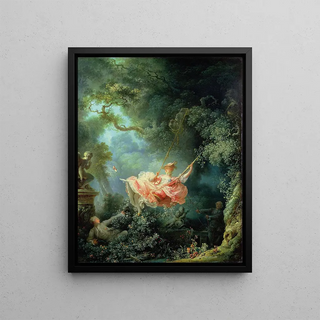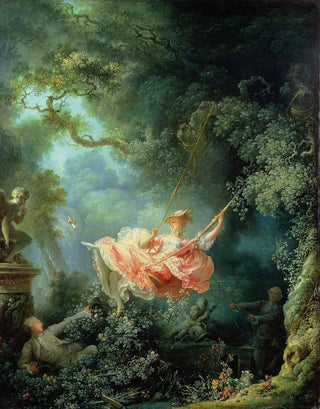Art print | The Swing - Jean-Honoré Fragonard Source: Reproduction | La Balançoire - Jean-Honoré Fragonard


View from behind

Frame (optional)
La Balançoire - Jean-Honoré Fragonard – Captivating Introduction
In the vibrant universe of 18th-century art, "La Balançoire" by Jean-Honoré Fragonard stands out as an iconic masterpiece of Rococo. This artwork, which evokes the lightness and carefree spirit of an era where pleasure and sensuality were celebrated, transports viewers into a world of dreams and escapism. At the heart of a lush garden, a young woman, dressed in a delicate gown, swings gracefully, embodying the spirit of frivolity and joie de vivre. The composition, both dynamic and harmonious, invites awe-inspired contemplation, where every detail is an invitation to explore the subtleties of life and human relationships.
Style and uniqueness of the work
The Rococo style, characterized by its exuberant ornamentation and pastel colors, finds here a particularly refined expression. Fragonard skillfully plays with light and shadow, creating a striking contrast between illuminated areas and those plunged into darkness. The young woman, at the center of the scene, seems to float in a dreamlike space, while the trees and flowers surrounding her add an almost fairy-tale dimension to the composition. The gestures of the characters, imbued with lightness, tell a story of secret love, where the knowing look between the young woman and the man hidden in the bushes suggests romantic tension. This work, while celebrating beauty and youth, also offers a critical perspective on the social conventions of the time, thus providing an unexpected depth to an initial impression.
The artist and his influence
Jean-Honoré Fragonard, born in Grasse in 1732, captured the very essence of his era. Raised in the artistic milieu of Paris, he was trained by masters such as François Boucher, from whom he inherited a taste for sensuality and lightness. However, Fragonard developed a unique style, marked by a personal vision of life and love. His influence extends far beyond his time, inspiring generations of artists who saw in his work a

Matte finish

View from behind

Frame (optional)
La Balançoire - Jean-Honoré Fragonard – Captivating Introduction
In the vibrant universe of 18th-century art, "La Balançoire" by Jean-Honoré Fragonard stands out as an iconic masterpiece of Rococo. This artwork, which evokes the lightness and carefree spirit of an era where pleasure and sensuality were celebrated, transports viewers into a world of dreams and escapism. At the heart of a lush garden, a young woman, dressed in a delicate gown, swings gracefully, embodying the spirit of frivolity and joie de vivre. The composition, both dynamic and harmonious, invites awe-inspired contemplation, where every detail is an invitation to explore the subtleties of life and human relationships.
Style and uniqueness of the work
The Rococo style, characterized by its exuberant ornamentation and pastel colors, finds here a particularly refined expression. Fragonard skillfully plays with light and shadow, creating a striking contrast between illuminated areas and those plunged into darkness. The young woman, at the center of the scene, seems to float in a dreamlike space, while the trees and flowers surrounding her add an almost fairy-tale dimension to the composition. The gestures of the characters, imbued with lightness, tell a story of secret love, where the knowing look between the young woman and the man hidden in the bushes suggests romantic tension. This work, while celebrating beauty and youth, also offers a critical perspective on the social conventions of the time, thus providing an unexpected depth to an initial impression.
The artist and his influence
Jean-Honoré Fragonard, born in Grasse in 1732, captured the very essence of his era. Raised in the artistic milieu of Paris, he was trained by masters such as François Boucher, from whom he inherited a taste for sensuality and lightness. However, Fragonard developed a unique style, marked by a personal vision of life and love. His influence extends far beyond his time, inspiring generations of artists who saw in his work a






